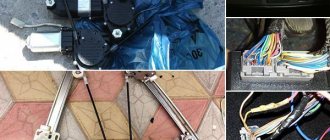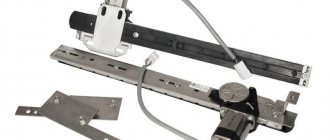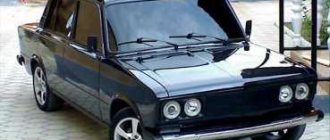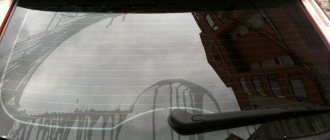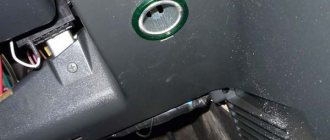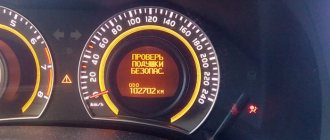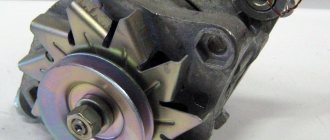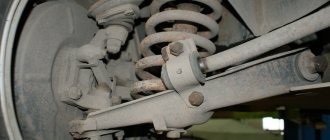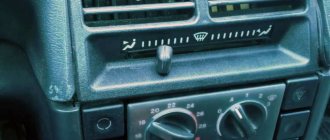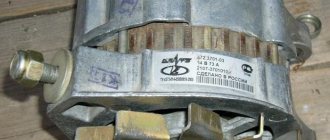Such a detail as the VAZ 2114 window regulator is the key to not only a comfortable, but also a safe trip in any weather. If it breaks down in rain or snow, the driver must stop driving on the road and carry out repair work or call a tow truck. Today we will talk about why window regulators break and how to completely replace them if necessary.
Window regulator VAZ 2114
Where is the door window lift located?
On cars of the Samara 2 family, different types of window lifters are installed, namely, there are electric ones in the front, and mechanical ones in the back (If the car is in a top configuration, then there are electric ones in the back), both types are hidden in the door itself and you won’t see them without removing the trim, so for For clarity, in the photo below, the trim was removed from the front door of the car, and the window regulator itself is indicated by a red arrow in this photo.
Installation Features
The connection diagram is the opposite of the above method of removing the device and, in general, has no special nuances. If you have completed the removal operation, then installing the VAZ 2114 electric windows will not be a problem.
The only nuance that you should not forget about is the window lifter guides. Before completing the connection, it is better to lubricate them - then the mechanism will last longer.
When should you replace your door window regulator?
If we are talking about an electric window lifter, then as a rule, when it fails, the glass stops going up and down when you press the corresponding button, in addition, on some cars (you most likely have already paid attention to this) it happens that the glass somehow goes down (Slowly ) and almost does not rise (you have to help with your hand), this also indicates that the window lifter has become unusable and requires replacement, but by the way, in some cases, due to the fact that the glass does not rise and fall poorly, it may not even be the window lifter itself that is to blame glass, it’s just that over time its fastening weakens and thus the glass becomes skewed, which is why problems occur with lowering and raising the glass on the car, but as for mechanical window lifters, everything is simple here, if by rotating the handle the glass has ceased to be adjusted, then the window regulator itself has failed and requires replacement.
Reason: broken button
Owners of VAZ cars, over time, begin to notice that the operation of the window regulators is slowing down. The cause may be problems with the mechanism buttons. Inside the part, there is contact between the plates, the quality of which deteriorates over the years. Over time, contact may disappear altogether. As a result, the window regulator does not work on a VAZ 2114 or on another model of a domestic manufacturer.
The main reason why a button may break is the failure of one of the window regulators. The likelihood that both buttons will fail is extremely low. It is worth noting that the mentioned parts have an identical design, which makes it possible for experimentation. Instead of a faulty element, you can install a button from a known good part.
Alternatively, replace the driver's door by using a knife or flat-head screwdriver to pry up the buttons and remove them from the chips. Next, install a working button in place of the broken one and connect it. If a previously faulty window regulator starts to work, then the cause of the problem lies in the button and it must be replaced (repaired).
How to replace the door window lifter on a VAZ 2113-VAZ 2115?
The window lifter on both the rear door and the front door is replaced almost identically, although there are small nuances, but you don’t even have to pay attention to this, and therefore if you learn how to replace the window lifter at the front, then you can also replace it on the back door and vice versa, but there is just one But! The window lifter can be replaced both with the glass removed from the door and with the glass installed (How you do it is up to you, if you don’t want to remove the glass, then in this case you can simply fix it with a screwdriver, but if suddenly the door moves a lot, then the glass may fall and break, but this won’t happen to you with the glass removed), if you still want to remove it, then in this case read the article entitled: “Replacing glass on a VAZ”, if you don’t want to remove the glass and are sure that it will not fall, then start reading the article; in it we just described the process of replacing a window lifter with the glass installed on the car door!
Removal:
1) Let's start with the front doors, but even if you replace the power windows only on the rear doors (And this is point 2), then still study point 1, because they are interconnected and from all these points you will understand more than just reading one of them, in general, before replacing, it doesn’t matter which door, but you will need to remove the trim from it, because the mechanism is located inside the door and without removing the trim you simply won’t get to it (For information on how to remove the trim, read the article: “Replacing front door on the car" points 1-8), after the trim is removed, disconnect the wire block and the connector that go to the window regulator (see photo 1), then remove all the nuts (there are only three of them) that secure the mechanism itself to door (see photo 2) and then unscrew the two bolts securing the window lifter slider to the glass frame itself (see photo 3), when the bolts are unscrewed, lift the glass to the very top if you have not removed it and fix it in this position (You can Use a screwdriver to fix it, see photo 4, or you can ask an assistant to hold the glass in the upper position).
So that the window lifter mechanism can be removed from the door and thereby completely removed, unscrew the two screws that secure the door opening handle to the car (see photo 1), after unscrewing the screws, remove the handle by pushing it into the inside of the door and through remove the cutout in the door (see photo 2), then using thin pliers or pliers or simply by hand, disconnect the rubber holder that holds the rod on the handles (see photo 3) and after that disconnect the rod from the handle and you you can completely remove it from the car in this way (see photo 4) and therefore, when the handle is removed, remove the window lift mechanism itself through the same cutout in the car door!
2) As for the rear door and window lifter, in order to remove it, take a wrench in your hands and use it to unscrew the three nuts that secure the mechanism to the door (see photo 1), as soon as the nuts are unscrewed, unscrew the two bolts that The slider with the glass is attached to the window lifter holder (see photo 2), then fix the glass in the same way as described in the first paragraph (see photo 3) and finally, when the glass is already stationary, unscrew the three nuts securing the mechanism to the door (see photo 4) and, also grabbing it with your hand, remove it from the door and thereby completely remove it.
Installation:
Everything is installed in its place in the reverse order, or, to put it simply, everything is put in its place in the reverse order of removal.
Principle of operation
Why do the power windows not work or only the right window does not go up? To understand exactly why the malfunction occurred, it is advisable to familiarize yourself with the operating principle of the unit. Typically, such a system has a trapezoidal design, which allows the windows to be raised and lowered by pressing switches. The buttons themselves can be located in all car door cards or located only in the driver’s door. It is also worth noting that an electric motor is mounted in each door, which operates in two directions.
In addition, each system is equipped with a special relay, the purpose of which is to control the voltage supplied to the electric motors of the structure. Depending on the vehicle, some car models may be equipped with automatic switches that are installed separately for each electric motor. The use of such structural elements makes it possible to ensure normal operation of the entire system if the window regulator is poor on only one door.
Design and types of window lifters
Window lifter for VAZ 2114
Window lifter for VAZ 2115, VAZ 2114 and other models of cars in this series can be of two main types.
The mechanisms on the VAZ 2115 or 2114 do not have any fundamental differences from other models of the family. The first of them is collapsible. They consist of two parts, a motor and a trapezoid, which are connected with fine thread bolts. If necessary, you can replace one of these parts while leaving the other. Previously, this was the most profitable option, since repairing a window regulator was much cheaper. Most often the trapeze had to be removed and replaced.
But in recent years it has been quite difficult to find high-quality trapeze on sale. Almost everything that is in stores lasts a month or two, and then again requires replacement. Therefore, collapsible device models are no longer so popular.
The second option is non-separable models. They are solid and do not allow the replacement of individual parts. On the other hand, a new non-removable factory window regulator for the VAZ 2113 and other models can last up to 3-5 years without requiring replacement. And with adequate use, even longer.
In addition to these types, devices are also distinguished by their operating principle. These are mechanical and electric windows of the VAZ 2114 and other models. The latter are also divided into lever, cable and rack and pinion. Their main difference is how the impulse of movement from the engine is transmitted to the plate holding the glass. This can be done by cable, lever or using a rack system.
1. Lever mechanism 2. Cable mechanism 3. Rack and pinion mechanism
Dismantling the old unit
If the electrical elements have been more or less decided, then the mechanical part of the problem is much more complicated. The described VAZ models have non-separable ESP structures. They are characterized as the most reliable, but in case of breakdown they require a complete replacement from the owner.
How the structure is dismantled.
- Remove the handle and rod.
- Lowering the glass, remove the holder.
- The glass is raised to the maximum and secured with tape.
- Unscrew all the nuts holding the mechanism to the door.
- Dismantling is complete and the device can be completely removed for diagnostics.
Next, you will decide whether to repair or replace with a new device.
Source: ladaprofi.ru
Common faults
Old and new mechanism
One of the most common malfunctions is gear wear. Usually plastic is used, which wears out quickly over time. A symptom of this problem is a rumble and crackling sound that is heard when the glass is raised or lowered.
Also, the automatic switch on the power windows may burn out, which is why the inclusion will not work. Also, problems may arise with the rear doors. They either stop working altogether or respond to pressing a key from the main unit, but not on the doors themselves. Check current continuity.
The electric motor may also fail. To fix it, you will need to check the voltage in it and the wiring. Mechanical damage to the guides may also occur.
Situations
There are situations where power windows stop working under repeated circumstances. For example, after driving on a dirt road or bumps, the mechanism begins to move the glass in jerks. When opening the casing, it is sometimes discovered that the wire has come out of the chip or from the connector, or after visiting a car wash, incidents begin with the glass. Perhaps the depressurization of the insulation contributed to the fact that moisture penetrated into the electrical components of the system and short circuits or disruption of communication between contacts began.
Chafing of the insulating layer of the wiring is one of the most common causes of problems with ESP. To facilitate diagnosis, it is worth observing what causes the standard fuse F6 to blow.
- If this moment is the activation of the lift itself, then, most likely, this place is somewhere under the door trim.
- If then, when you turn on the ignition, then it is worth checking the insulation of the wires from the door to the safety assembly block.
One of the weak points is where the bundle of wires goes from under the hood to the door trim.
Removal instructions
Disassembled door
If you don’t know how to remove the window lifter handle, don’t despair, it’s easy to do. Before removing the mechanism, you need to remove the trim from the door. Then be sure to disconnect the wire block and the power window connector. Then remove the three nuts that secure the mechanism to the door. Next are two bolts that secure the lift and the glass itself.
Dismantling process
Then, lift the glass to the very top and fix it, you can use a screwdriver or ask someone to hold it. But it’s better to pull it out, because otherwise there is a risk that the glass may break.
To completely remove the mechanism, you need to additionally remove the door handle. To do this, unscrew its two screws and push the handle inside the door. Then, you will need to disconnect the rubber holder that holds the rod on the handle. Once you're done with this, you can pull out the handle, and then the window regulator itself through the same hole. Now you know how to remove the window handle and the entire mechanism.
Tips for motorists
As standard, on a VAZ-2114 car, only two window lifters are installed on the right and left sides of the front doors. If a malfunction is identified due to the failure of both power windows, you will first have to check the thirty-amp fuse F6, located in the mounting block under the hood of the car.
If it is burnt out, then it needs to be replaced with a new one. Well, the driver will have to look for the reason for the failure of this fuse, because if this is not done, then the new fuse will burn out in the same way. When searching for a short circuit, it is necessary to take into account at what point the fuse blows. If this happens when the power window is turned on, then most likely there is a short circuit under the door trim, and if the fuse burns out immediately after the ignition is turned on, then most likely the wiring is shorted to ground, somewhere from the mounting block to the door trim.
The weak point that leads to chafing of the insulation of the wires going to the electric window lifter motor is the transition of the bundle of wires from the passenger compartment under the door trim. Therefore, this place needs to be checked first.
If the fuse is intact, then you will have to remove the door trim and check the voltage at the contacts in the plug connectors of the wires suitable for the window lift motor. This can be done very simply using a test light (one wire to the contact, the second to ground, if the light is on, it means there is voltage). If there is voltage and the window lift motor is not working, it will have to be replaced.
In addition to the fuse, the cause of the window regulator not working can be the failure of the K5 relay located in the mounting block. A relay that is not working is usually replaced with a new one. Sometimes, the window lift motor stops working as a result of warping of the thermobimetallic fuse built into the motor to protect it from overloads.
Also, the cause of a non-functioning window lifter can be mechanical faults. These include: failure of the worm gear, which serves to reduce the rotational speed of the electric motor shaft, and problems associated with the cable drive. During operation, the window lift cable stretches and increases in length, which leads to incomplete lowering of the side window. In addition, the extended cable can jump off the guide rollers and then there is nothing to move the side window.
The window regulator slowly raises the glass - what should I do? There is a solution!
Hi all! Dear friends, you are all aware of what “jambs” and shortcomings each of us “happy” owners of domestic VAZ cars have to eliminate. Today’s article is another life-saving solution for those who are faced with the problem of poorly functioning beet lifters.
Electric windows (ESP) have been installed on foreign cars for decades, so, as a rule, there are no problems with them, which cannot be said about VAZs. On “our” swallows, such a miracle has been occurring for about 10 years, and as practice shows, the good old “meat grinders” in the form of a simple mechanical handle worked much more reliably. Get to the point! A defect was noticed on many models from 2109 to 2115, where, as a rule, the front right glass does not rise well. Moreover, the window lifters slowly raise somewhere from the middle or even lower, the glass slows down or stops rising altogether. At the same time, drivers help the ESP either with their hand or with a “clarion word”.
Serial connection - diagram
We connect the output of additional button 1 in the driver's door to input 6, and output 7 to input 3 of the main button on the passenger door. We cut the wires in the block connecting contacts 5-6 and 6-3. The minus of contact 5 now goes only to the backlight, and contacts 6 and 3 now take output from additional buttons 1 and 7 of the driver's door. Installation in parallel will result in short-circuiting during lifting and lowering. Power wires are highlighted in bold.
When using trigger buttons, connect all ESP motors only through a relay. When using a conventional door closer, relays are also needed, since they are not in the long-press closer block and all the current flows through the buttons and wires from them.
Relay
If the fault cannot be identified, we move on to the mechanism relay. In the diagram it is marked with a special icon and is designated K5. Located at the bottom left. To check the functionality of the relay, it is better to replace it with a known working one and see if the mechanism functions.
The relay is responsible for closing the contacts when the ignition switch is turned on, so that there is no additional battery consumption when the car is parked. But over time, it may stop working, which is why even with the ignition on, voltage will not be supplied to the system.
The most common reasons why the VAZ-2114 window regulator does not work
There is no point in arguing that power windows significantly increase the operating comfort of a car. But most drivers also know that they cause a lot of trouble. By the way, when it comes to the breakdown of the mechanism, we must not forget that the problem may not be in it, but in the glass itself. Over time, the holder or seals wear out, which often leads to a banal misalignment, which significantly impedes the freedom of movement of the glass.
The design of the window lifting mechanism is quite simple, but not reliable. And the fact that the safety block is placed in a place where moisture and dirt can easily get in is also not a plus. As you know, the slightest wear of the insulation can lead to a short circuit and breakdown of the entire system.
The most common reasons why a window regulator fails are the following:
- Damage to the components of the control unit.
- The contacts have oxidized and the circuit has opened.
- Disconnecting the power supply.
- The control button has stopped performing its functions.
Yes, most often car enthusiasts are faced with the fact that this component of the window regulator fails.
Key repair
If the driver is convinced that the cause of the malfunction is in the button, he can fix the problem himself as follows:
- The first step is to disassemble the door panel.
- Then the connector is disconnected, the fastener holding the button board, on which 4 contacts are located, is unscrewed. If they are oxidized, they need to be cleaned.
- It would also be useful to inspect the springs and check the functioning of all elements.
- The next step is to apply conductive glue to the surface of the rubber shell at the point of contact between the contacts and the printed circuit board.
When it dries, all components are assembled and installed back.
Fuse
When problems appear with the operation of the mechanism, the first thing to check is the condition of fuses F5 and F16. F5 is the fifth from the top on the left, and F16 is the bottom on the right. They are responsible for the operation of the window lift mechanism on the car. Fuse F1 may also affect the operation of the power windows.
Remember, the element cannot burn out just like that; this usually happens when the wire is short-circuited to body ground. If during replacement the new protective element also burns out, you need to inspect the entire system wiring diagram.
Tracks or contacts in the mounting block
Another reason may be a broken contact of the mechanism relay in the mounting block.
Considering the circuit of the mounting block, we can conclude that a constant plus comes to pin 30 through a fuse, and when we turn on the ignition, we apply another plus to pin 85. As a result of turning on the ignition, an electromagnetic field appears, which closes pins 30 and 87, which provides power to window lift buttons.
This means that if the operation of the plus on the ignition switch is disrupted, the contacts stop closing, even if the relay is in working condition. You can check this by closing contacts 30 and 87 directly, then the plus will come without the ignition switch and if the problem is in it, then the power windows will work.
The video demonstrates another solution to this problem:
But there may also be the opposite situation, that we do not have a constant positive supply to pin 30, and when we turn the ignition key, the contacts close, but nothing happens. In this case, it is best to ring the contact with a tester and find out whether there is constant voltage. For testing, you can connect the plus directly to pin 87, but this is not safe, since the wire will go outside the fuse.
The principle of operation of a car window lifter
The ability to switch between raising and lowering the windows is made possible by equipping the electric motor with a reverse power system. Structurally, the motion vector is changed either using a relay or directly through a switch. Window lifters of the latest generations are more complex, which is caused by the need to increase the safety of their use and increase comfort. Functions of modern mechanisms for automatically raising/lowering windows:
- uniform movement in one of the directions to the end point;
- discrete movement (for example, an inch) in one direction or another;
- slow mechanism locking;
- return movement (used to have time to remove part of the body from the window opening).
The window regulator control unit is the brains of the device, which includes, in addition to the control microcircuit, an electric motor relay, switches and electrical wiring connecting the control unit to the door lock and the top hatch cover. If you activate the window lift mode with one touch or command, it will move in the specified direction. As soon as the switch is moved to the reverse position, the motor will stop. The same will happen if the power window ECU receives a corresponding signal from the door circuit board.
The main problem with using the one-touch mode is the high likelihood of injury to a child who is leaning out of the window, even partially. The return mode helps prevent such situations. To do this, another switch is mounted to the electric motor armature, the task of which is to transmit a special signal to the ECU with a frequency proportional to the rotation speed of the power unit. If, while closing the window, the computer detects a decrease in the engine speed below a certain value, it will immediately issue a command to change the direction of movement of the glass until it is completely lowered.
The control unit is able to calculate the current position of the window based on counting the number of received pulses. This information is used to prevent reversal of the window movement if it is completely closed or, conversely, lowered. However, the ECU must know the initial position of the window. To do this, an initialization operation is performed, which consists of turning on the electric motor until the glass is completely opened, after which the reverse operation is performed - closing it. Without initialization, the power windows will stop working in one-touch mode.
Some models of window regulators are equipped with Hall sensors, which make it easier to determine the current speed of glass movement. Another common way to control speed is to monitor the amount of current consumed by the motor, which is proportional to the speed of rotation of the motor shaft. The “slow blocking” mode is used if it is necessary to completely block the vehicle by issuing a command sent remotely from an infrared remote control. This function uses the connection between the power window/sunroof control unit and the door lock. The order of operation is as follows: windows, hatch, doors. If necessary, it is possible to activate the security mode - in this case, the windows will close one at a time - this reduces the instantaneous current consumption (compared to simultaneous closing).
